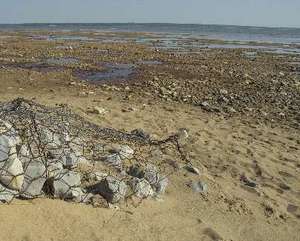Either way, weather is the reason for this year's unprecedented decline and it's going to take long periods of above-average precipitation to get things back to normal, insists David Fay, Canadian member of the International Lake Superior Board of Control.

|
| ©Michael Purvis |
| Low water levels are visible at Point Des Chenes, northwest of the Sault, where Lake Superior has receded far from the beach this year. |
Shallow docks have been left high and dry this year and swimmers have been forced to walk further to get wet, as Lake Superior dropped to 53 centimetres below normal for the beginning of June and 40 centimetres below last year's level. That's just 10 centimetres higher than the record low, recorded in 1926.
"It's consistent with what might be happening with climate change, but we can't say for certain it is caused by climate change; it could just be natural variation," said Fay.
Fay, who works with Environment Canada in Cornwall, Ont., was one of three experts at a public forum Wednesday night in Sault Ste. Marie to address the lake's level, which has reached its lowest level yet after nine straight years of below-average readings.
Fay showed a chart detailing the sharp ups and downs water levels have undergone over roughly the last 100 years. Several times over that period Superior's water level has taken a sharp dip only to rebound in subsequent years well above average levels. Because the charts show Superior once went this low before, it could rise again, "just as it has in the past," Fay noted.
Fay's explanation was met with skepticism from the public, many of whom recounted stories of rapidly declining water levels last fall and were reluctant to accept that precipitation was the only factor.
Several suggested officials should look closer at water flowing through the St. Clair River, and at current water diversions and the possibility of future ones.
Dave Edgar said he watched in amazement between September and October as the water dropped 13 inches on a scale posted to the dock in front of his property just north of Harmony Beach.
"I think there has to be a better answer than evaporation," said Edgar, 59. "There's some other factor there and I don't know what it is, but there's something."
Murray Sayers, who lives on Batchewana First Nation's Obadjiwan Reserve at Batchawana Bay, said his plans for fishing this year have been hurt by low water. Sayers, whose son is Chief Dean Sayers, said he came to the meeting hoping to hear a way that declining levels could be avoided.
His wife, Betsy Sayers, said she felt the panel was "beating around the bush," with their explanations.
"They're hiding something; I've been here all my life and I can't see Lake Superior going down that fast," she said.
The forum was hosted by MP Tony Martin, the Lake Superior Conservancy and Watershed Council, the Bi-National Public Advisory Council, Batchewana First Nation and the St. Mary's River Joint Anishinawbek Task Force.
Both Fay and Tom McAuley, with the International Joint Commission, insisted there are no quick fixes to what is causing Lake Superior's water to decline.
"I sympathize, but there's no magic drain that can be turned off," said Fay.
McAuley said some may be looking for "a bad guy, something that we can fix quickly or change quickly."
"Unfortunately that's not the case in Lake Superior," he said.
The IJC, an independent body established by the Canadian and U.S. governments to resolve and dispute issues touching on shared waters, has recently begun a five-year study meant to explore decreasing water levels on lakes Superior and Michigan-Huron.
The $17.5-million study will look at the St. Clair River, as well as climate change, and other factors.
However, the St. Clair issue doesn't apply to Lake Superior, said Fay.
On Superior "it's weather," either linked to climate change or to normal variations, he said.



Reader Comments
to our Newsletter